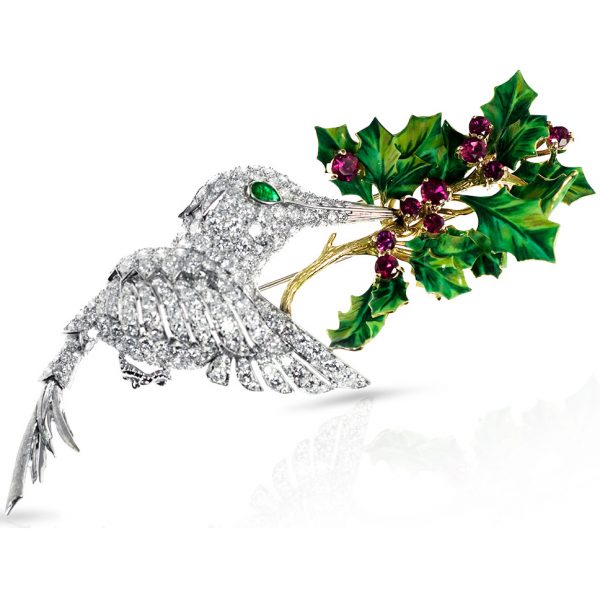
No jewelry request is too big, too small, or too outrageous for these visionary designers and retailers.
A pair of jasper cufflinks carved and painted to resemble a client’s pet dogs; a wide platinum band dotted with inherited diamonds; a gold egg that opens to reveal an engraved family tree. All were produced by jewelers in response to a request—some might call it a challenge—from customers eager to take home a one-of-a-kind treasure.
Twenty years ago, custom jewelry design referred to little more than mixing and matching stones in premade settings. “When my dad and my grandfather custom-made jewelry, they would open a casting catalog, show the client a picture, order it, and do a few adaptations,” says Lee Krombholz, third-generation owner of Krombholz Jewelers in Cincinnati. “Very few jewelers at that time would carve waxes and design a fully custom piece because it was a fairly expensive process.” Today, Krombholz chairs the newly formed Council of Custom Jewelers of Manufacturing Jewelers & Suppliers of America (MJSA) and considers custom work an integral part of his 76-year-old retail business, with commissions such as that golden family-tree egg.
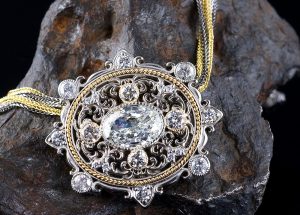
A range of Krombholz Jewelers custom pieces, from a wrought-iron-style pendant (above) to a diamond-studded bird brooch (top)…
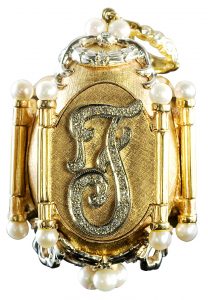 .
. 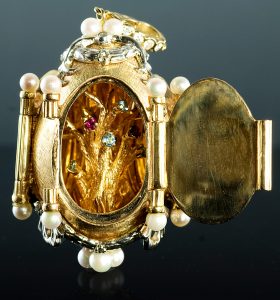
…to the infamous golden-egg family-tree pendant.
The rise in custom design can be traced on one hand to consumer demand, particularly among millennials in search of a unique accessory, and on the other hand to the use of CAD software that allows jewelers to create 3-D models with endless variations in detail. “I can’t draw a straight line with a ruler,” jokes Matthew Patton, a fourth-generation jeweler in Baton Rouge, La. But thanks to design software, he has spent the past two years pursuing his passion for custom design at his Cut Fine Jewelers, where 90 percent of his business is custom.
“I’m not the traditional retailer that buys a bunch of jewelry, puts it in a showcase, then hopes everybody comes in and likes what I’ve got,” says Patton, who specializes in top-quality diamonds in intricate settings. “We want to make it to order.”
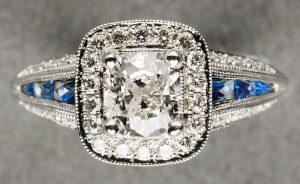
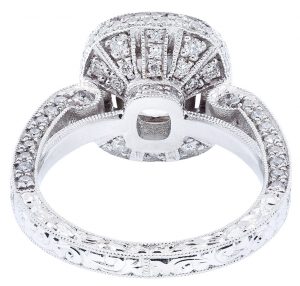
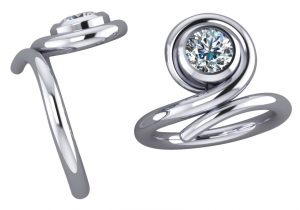
Ornately set diamond rings are a specialty of Matthew Patton’s at Cut Fine Jewelers.
Noting that clients typically have a limited vision of what’s possible when choosing, say, an engagement ring, Patton begins with a detailed consultation. For a couple raised in New Orleans, he designed a ring that echoes the curves of iron balconies in the French Quarter, with tiny diamonds set in the filigree under the center stone. The process is made easier by CAD models (Patton favors software from Matrix or Rhino), which can be revised and printed in wax to show exactly what the finished piece will look like.
Reinventing vintage pieces is a hallmark of designers like Sarah Ortega, who followed her mother into the business at Ooh! Aah! Jewelry retail stores in Denver and Albuquerque, N.M. Ten years ago, Ortega introduced her Sarah O. line of customizable bridal jewelry in styles both dainty and edgy.
“I’m fascinated by old diamonds and mine cuts,” Ortega says, “and I love helping customers repurpose heirloom pieces that have sentimental value but may not be practical anymore because the metal is too thin.” Her first custom project—she plucked three diamonds from a client’s family pieces and hammer-set them side by side in a thick platinum band—remains a favorite.
Ortega’s biggest challenge: finding employees with CAD design skills “who can think outside the box. Somebody who will take a ring and copy it? No. They have to get creative with the stones, because that’s what customers are looking for. They come to us for ideas and inspiration, and we have to show them something they’re not going to find anywhere else.”
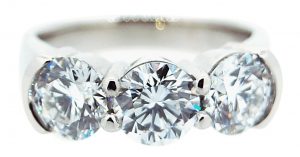
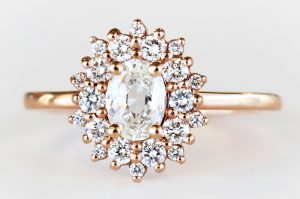
Rings by Ooh! Aah! Jewelry’s Sarah Ortega, including one featuring a trio of a customer’s family stones
Custom via Computer
To help traditional retailers get started in the custom market, manufacturing giant Stuller and its Gemvision technology division created CounterSketch, an easy-to-use software program that allows shoppers to scroll through thousands of options on an in-store computer screen that can be printed in 3-D, produced by Stuller, and shipped in 10 days or less.
“Millennial buyers shop online before buying, and they’re used to dealing with technology every day,” says Gemvision sales director Doug Kerns. “CounterSketch gives them a reason to go to a jewelry store, and the retailer can offer custom designs without having to stock excess inventory.”
Krombholz praises CounterSketch’s real-time pricing feature. “As you’re working with the client, the program figures out the weight of the metal and the size of the stones, and when you’re finished, you can push a button, get a price quote, and order the piece.”
CounterSketch is considered a “semi-custom” option in MJSA’s new three-tier definition of custom jewelry, which the trade association is putting in place to help shoppers understand their choices. “In a recent survey of our 350 members, 24 percent identified themselves as custom jewelers,” says MJSA spokesman Rich Youmans, “but there is a spectrum of ‘custom’ that can create confusion among consumers. A ‘full custom’ jeweler works at the bench to design and build a piece, and the craftsmanship is exceptional.” The middle tier involves adapting and personalizing existing design elements. In the third tier, designated “made to order,” a catalog model is tweaked through choice of metal and gemstones.
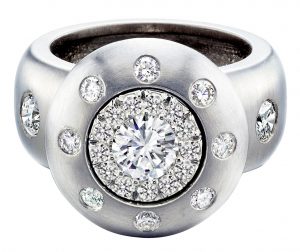
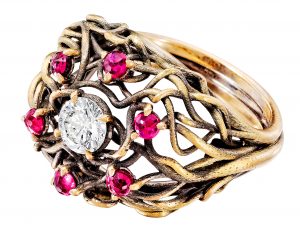
Custom engagement designs by Wendy Brandes: a platinum and diamond ring (based on her own), and a nontraditional 18k gold style
Client Servers
Designers have long embraced the “full custom” option as a means to develop a loyal clientele. At one end of the spectrum is Wendy Brandes, whose cheeky designs and sassy blog have driven sales since she founded her brand online a decade ago. “All of my jewelry experience comes from the fact that I couldn’t find what I was looking for in a store,” explains Brandes, a former journalist. Her first creation was her own engagement ring, a bold platinum band with a center diamond surrounded by eight widely spaced smaller stones and two more on the shank. The ring attracted the attention of a customer who had stopped wearing her delicate solitaire.
“She said, ‘I wish my engagement ring looked like yours,’ and I said, ‘Well, I’ll make it look like mine,’ ” says Brandes, adding with a laugh, “I had to add about three carats to it, but she loved it!” With a website that promises, “If you can describe it, she can create it,” Brandes has produced those jasper dog cufflinks (one boxer, one Jack Russell terrier), a stacked engagement ring in mixed metals, and a man’s wedding band carved in a Celtic design, among many other commissions. “Once people see what is possible,” she says, “they feel more comfortable breaking out of a traditional look.”
On the superluxury end of the custom market is Sharon Khazzam, who began her career as Asprey’s in-house designer and now offers her own jewel-encrusted earrings, rings, bracelets, and pendants at select Barneys locations. “Every piece I have ever designed has been one-of-a-kind,” she says, inspired by her evolving gem collection or by an idea that leads to a drawing. No computers for Khazzam—she makes her own wax layouts based on drawings and sends them to a New York City–based jeweler to convert into metal. Longtime clients often receive a framed original watercolor of their latest acquisition, all cataloged in Khazzam’s Great Neck, N.Y., studio.
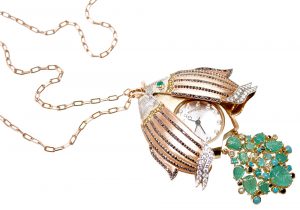
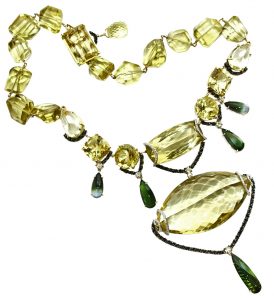
Sharon Khazzam takes a timeout in 24k gold, emeralds, diamonds, and paraiba—and goes
long in lemon citrine, green tourmaline, and diamonds.
“We’re not just selling ‘stuff,’ ” she says lightly. “We’re selling a jewel that we hope will be appreciated and enjoyed now and then passed on to a family member.” Last fall, Barneys debuted an in-store “bespoke event” with Khazzam in which jewelry collectors were invited to meet the designer and peruse a tray of gemstones that she then transformed into custom jewelry. “Following the journey of creation makes a piece that much more special,” she observes. “Barneys is inviting clients in to re-create the experience they would have in my studio.”
That moment a customer first sees her grandmother’s diamond in a shiny new setting or a bride-to-be is presented an engagement ring inspired by her Pinterest dream board makes all the effort worthwhile. “The best part of custom design is when the customer opens the box,” Ortega says. “I wish I had a video camera to record the tears and laughter. It’s such a cool feeling to see everyone so happy about a piece of jewelry.”